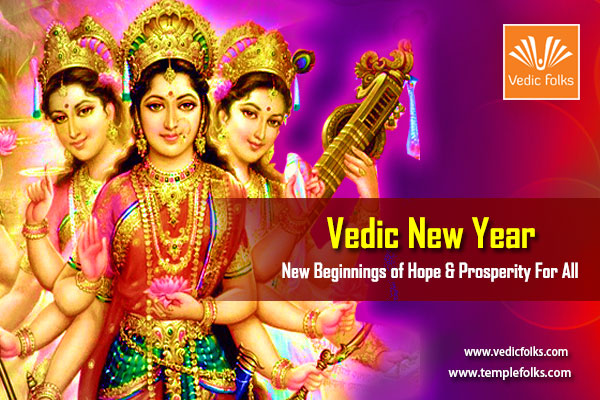Vedic New Year
New Beginnings Of Hope & Prosperity For All
A Beautiful Season Before The Sweltering Summer
The earth travels in an elliptical path around the Sun at an angle of 360 degrees and the time taken to complete one such revolution is called aandu (in Tamil) or year. This elliptical path with Sun in the centre is divided into twelve arcs, and each angle measure around thirty degrees. This is called the rasi/house or zodiac. Thus the earth passes through twelve zodiacs or houses.
But the first house the Sun enters is the Aries or Meda Rasi and this is taken as the starting point of the New Year called Chithirai Matham. It is also the month of ‘ilavenil kalam’ or mild Sunny period that starts mid April and ends mid June. And mid April is the time when the Tamil New Year arrives with all its glory and resplendence. It brings along a mild breeze that is so soothing and refreshing and that is the reason why Tamil Saiva saint Thirunavukkarsu Nayanar compared the pleasure of being at the Lord Shiva’s feet which is equal to the pleasures of the beautiful season.
“Maasil Veenaiyum Maalai Mathiyamum
Veesu Thendralum Veengu Ilavenilum
Moosu Vandari Poikaiyum Pontrathe
Eesan Enthai Inai Adi Nilale“
How Saturn & Jupiter Transitions Are Calculated
Maybe that’s the reason why Tamil scholars of yore selected this pleasant season as the dawn of Tamil New Year. They also considered the average life span of a person as sixty years and believed in cyclic system. There are sixty years in one cycle each having a different name. At the end of the sixtieth year, another cycle of sixty years bearing the same names begin.
Now why do Tamil calendars have a 60-year cycle? Well, among the Navagrahas or nine planets, Saturn and Jupiter take the longest duration to revolve around the Sun. While Jupiter takes 12 years to go round once, Saturn takes 30 years. Sages of ancient times classified the visible sky into 12 rashis or constellations. That’s why in astrology one encounters the Jupiter transitions every year and Saturn Transition every two and a half years i.e. 12×2.5=30. So, it was decided that all planets align themselves in their original position every 60 years (60 being the LCM for all rotational periods of the nine planets. Therefore, there are 60 years in the Tamil calendar and each year has a specific name. This is the year of Vilambi, a not-so-beneficial year for all but powerful rituals to deities can go a long way in making this year a prosperous and successful one.
By looking into the Tamil literature, one finds there are several references to the New Year starting April. Nakkirar, Sangam period author of the Netunalvatai, wrote in the third century that the Sun travels from Mesha/ Chithirai through 11 successive signs of the zodiac. Kudalur Kizhaar in the third century refers to Mesha Raasi/ Chithirai as the commencement of the year in the Purananuru. The Tolkaapiyam is the oldest surviving Tamil grammar that divides the year into six seasons where Chithirai marks the start of the ‘Ilavenil’ season or summer. The Silappadikaaram of eighth century refers to the 12 Raasis or zodiac signs starting with month of Mesha /Chithirai.The Manimekalai points to the Hindu solar calendar as we know today.
Tamil New Year Observed In Different Parts Of The World
An early medieval commentator regionally known as Urai-asiriyar, Adiyarkunalaar has cited the 12 months of the Tamil calendar with special reference to Chithirai. Subsequently, such inscriptional notes were made in Pagan, Burma in the 11th century and Sukhothai, Thailand in the 14th century. Often, south Indian Vaishnavite courtiers were given the task of defining the traditional calendars that began in mid-April.
In Kerala, West Bengal, Assam, Manipur, Mithila, Odisha, Tripura and Punjab, and in Nepal, Bangladesh, Burma, Cambodia, Sri Lanka, Laos and Thailand follow the new year similar to the Tamil calendar. The 60-year cycle is ancient and is observed by most traditional calendars of India and China, and is related to five revolutions of Jupiter, or to 60-year orbit of stars or Nakshatras as explained in the Surya Siddhanta.
Keralites all over world celebrate the festival of Vishu and view the Vishukkani, first thing before dawn, on the day. Vishukkani is a ritual arrangement of material items like new clothes, money, jewellery, and new crops etc. that signify prosperity. It is said that seeing these first in the morning of the New Year day is very auspicious and that one would be excessively blessed and prosperous for the rest of the year.
In Orissa the New Year is celebrated as Pana Sankranti, in West Bengal as Poila Boishak, in Assam as Bihu and in Punjab this day is observed as Vaisakhi.


















